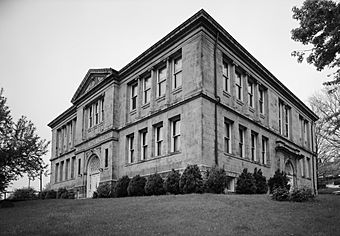Carnegie Free Library (Connellsville, Pennsylvania) facts for kids
Quick facts for kids |
|
|
Carnegie Free Library
|
|

Carnegie Free Library, May 1989
|
|
| Location | S. Pittsburgh St., Connellsville, Pennsylvania |
|---|---|
| Area | 1.5 acres (0.61 ha) |
| Built | 1901 |
| Built by | Nixon, J.A. |
| Architect | McCollum, J.M. |
| NRHP reference No. | 81000542 |
| Added to NRHP | October 8, 1981 |
The Carnegie Free Library in Connellsville, Pennsylvania is a historic building with a fascinating story. It's a special type of library called a Carnegie library, named after the famous businessman and giver, Andrew Carnegie. He helped build many libraries across America and other parts of the world.
A Gift from Andrew Carnegie
Andrew Carnegie was a very successful businessman who believed in the power of education. He thought that everyone, no matter how much money they had, should have access to books and learning. Because of this, he decided to use his wealth to fund the building of libraries.
The Carnegie Free Library in Connellsville was built in 1901. Andrew Carnegie himself gave $50,000 to help pay for its construction. This was a huge amount of money back then! He officially approved the grant on April 22, 1899. This library was actually the 13th one he helped build in the United States.
What the Library Looks Like
The library building is a two-story structure with a basement. It was designed in a style called Italian Renaissance Revival. This style gets its inspiration from the beautiful buildings of the Italian Renaissance period, known for their grand and elegant look.
The library is made from a light-colored stone called Ohio buff stone. It has a decorative border, or cornice, made of terra cotta. Terra cotta is a type of baked clay often used for decoration. The roof is covered with red Spanish tiles, which add a lovely touch of color. The building is quite large, measuring about 92 feet long and 74 feet wide.
A Place of History
Because of its unique architecture and its connection to Andrew Carnegie, the Carnegie Free Library is considered very important. It was officially added to the National Register of Historic Places in 1981. This means it's recognized as a special place that should be protected and preserved for future generations.



